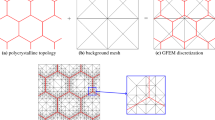Abstract
The theory of Clarke for the formation of grain boundary cracks in anisotropic polycrystalline materials, is re-examined in the light of recent experimental data. The theory predicts correctly the conditions for the formation of grain boundary cracks of length similar to a grain dimension. However, the theory cannot be used to explain the experimentally observed strength/grain size and strength/irradiation dose relationships, for example for BeO. The theory supposes that the process controlling catastrophic fracture is the growth of a crack from a grain boundary pore with an energy absorption rate corresponding to the grain boundary surface energy of ∼103 erg/cm2. In practice, the process controlling catastrophic fracture is the subsequent growth of a crack from a grain dimension, with a higher energy absorption rate corresponding to an effective surface energy of ∼104 erg/cm2.
Similar content being viewed by others
References
T. W. Baker, P. J. Baldock, andF. J. P. Clarke,J. Nucl. Matls. 14 (1964) 203.
F. J. P. Clarke,Prog. Nucl. Energy 5 (1963) 221.
Idem, Acta Met. 12 (1964) 139.
Item, J. Nucl. Matls. 11 (1964) 117.
F. J. P. Clarke, R. S. Wilks, andD. H. Bowen,ibid 14 (1964) 205.
F. J. P. Clarke andR. S. Wilks, Proc. Conf. Nuclear Applications of Non-Fissionable Ceramics, edited by A. Boltax and J. H. Handwerk (American Nuclear Soc., 1966) p. 57.
H. J. Woolaston andR. S. Wilks,J. Nucl. Matls. 11 (1964) 265.
G. L. Hanna, G. T. Stevens, andB. S. Hickman, AAEC/E 127 (1964).
C. G. Collins,J. Nucl. Matls. 14 (1964) 69.
J. P. Roberts,Proc. Phys. Soc. 62B (1949) 248.
J. F. Quirk, N. B. Mosley, andW. H. Duckworth,J. Amer. Ceram. Soc. 40 (1957) 416.
G. C. Bentle andR. M. Kniefel,ibid. 48 (1965) 570.
R. E. Fryxell andB. A. Chandler,ibid. 47 (1964) 283.
J. S. O'Neill, N. A. Hill, andD. T. Livey,Proc. Brit. Ceram. Soc. 6 (1966) 95.
F. J. P. Clarke, H. G. Tattersall, andG. Tappin,ibid p. 163.
H. G. Tattersall andG. Tappin,J. Matls. Sci. 1 (1966) 296.
R. W. Davidge andG. Tappin,ibid 3 (1968) 165.
R. W. Davidge andF. J. P. Clarke,Bull. Soc. Fran. Ceram. 72 (1966) 61.
S. C. Carniglia,J. Amer. Ceram. Soc. 48 (1965) 580.
Author information
Authors and Affiliations
Rights and permissions
About this article
Cite this article
Davidge, R.W., Tappin, G. Internal strain energy and the strength of brittle materials. J Mater Sci 3, 297–301 (1968). https://doi.org/10.1007/BF00741965
Received:
Issue Date:
DOI: https://doi.org/10.1007/BF00741965




